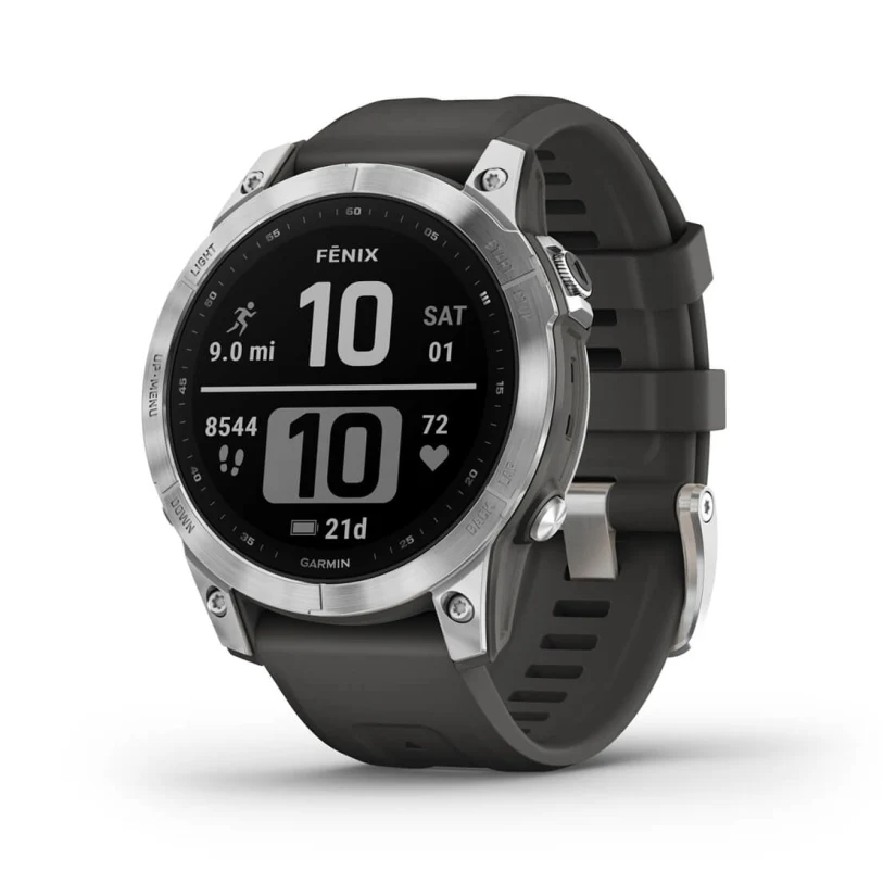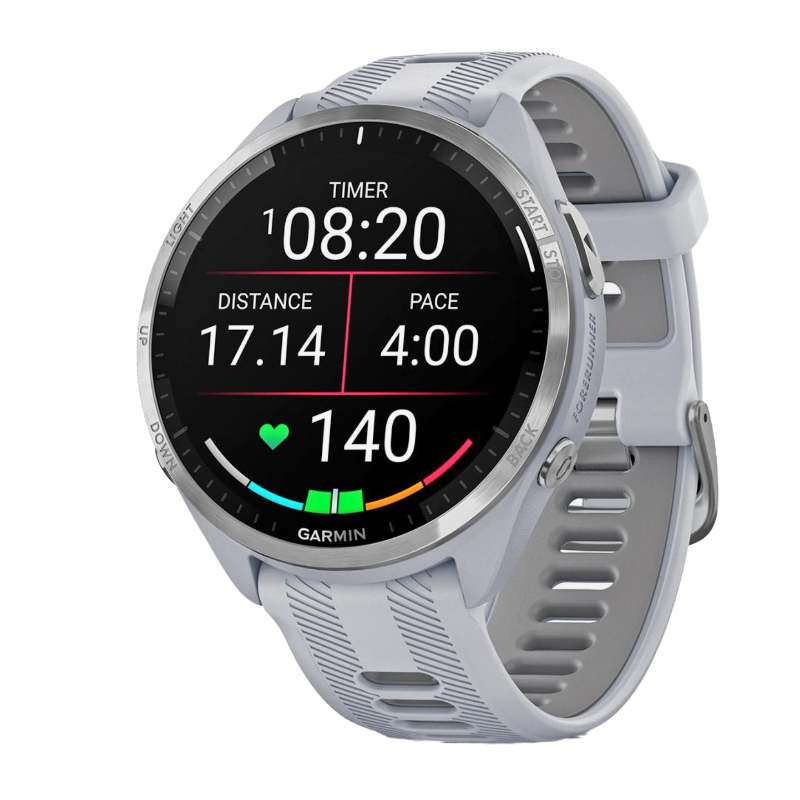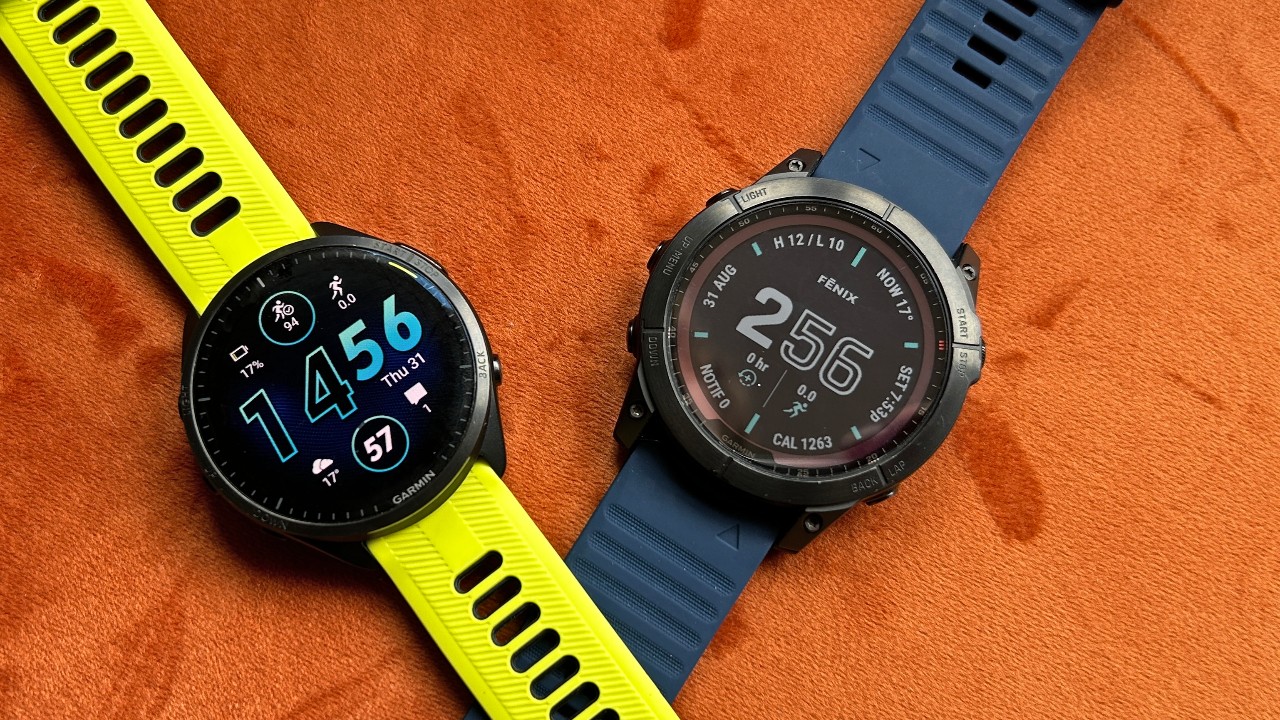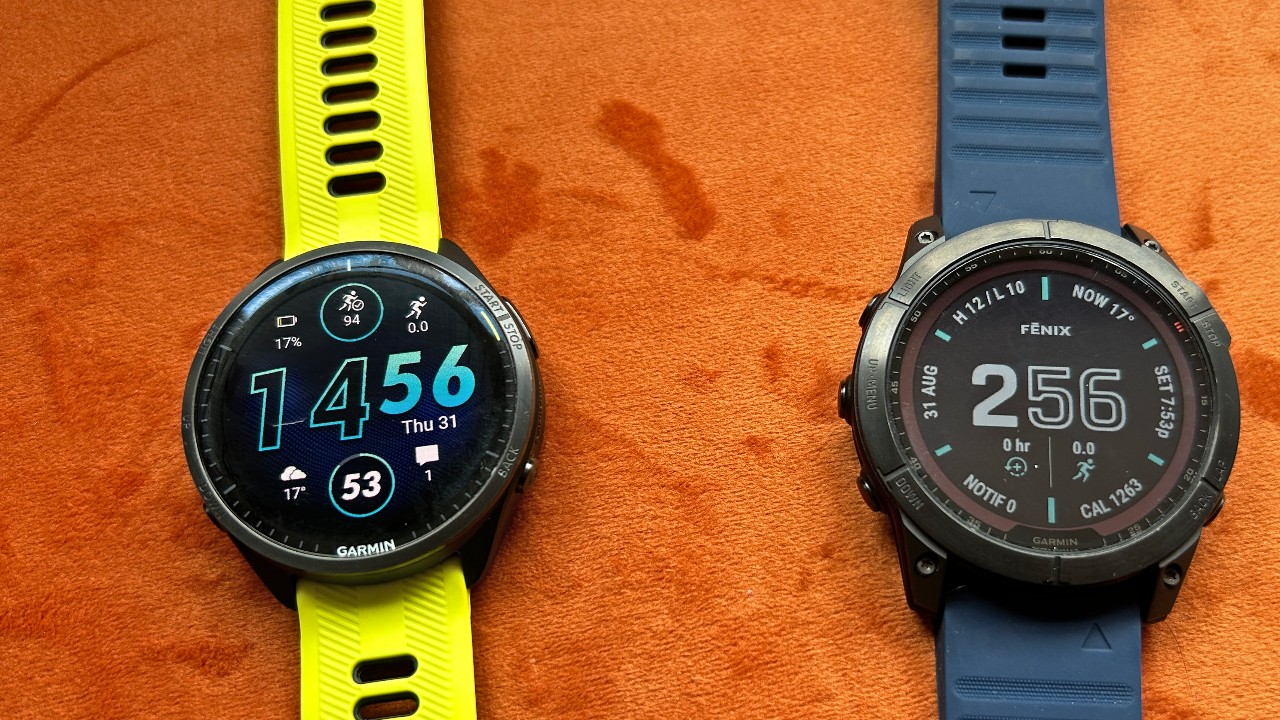Garmin Fenix 7 vs Garmin Forerunner 965
The Garmin Forerunner 965’s AMOLED display stands out when comparing these two top sports watches

The Garmin Fenix 7 has a more durable and classy design than the Forerunner 965, and comes in a wider range of sizes and materials. It doesn’t have an AMOLED screen, but its duller display comes with the benefit of longer battery life.
For
- Range of sizes and designs
- More durable than the 965
- Longer battery life than the 965
Against
- No AMOLED screen
- Heavier than the 965
- Only sapphire models have multi-band

The lightweight Forerunner 965 has a large, gorgeous AMOLED screen and while it doesn’t match the battery life of the Fenix 7, it’s still pretty long-lasting for an AMOLED watch. It’s also cheaper than most models of the Fenix 7, especially if you want multi-band GPS.
For
- Lighter than the Fenix 7
- Cheaper than the Fenix 7
- AMOLED screen
Against
- Not as durable
- Shorter battery life
- More plastic design
The Garmin Forerunner 965 and Garmin Fenix 7 offer the same excellent array of software features, but have big differences in design. The Forerunner 965 has a light frame and a bright AMOLED display, while the Fenix 7 has a more rugged design and a memory-in-pixel screen that means it lasts longer on a charge. Both are among the best sports watches available, but which suits you better depends on the design you prefer.
Garmin Fenix 7 Vs Garmin Forerunner 965: Price And Availability
The Garmin Fenix 7 range launched in January 2022 and contains a variety of watches in three sizes: The Fenix 7S is the smallest model, the Fenix 7 is in the middle, and the Fenix 7X is the largest.
If you opt for a steel Fenix 7S or Fenix 7 it will cost $699.99 in the US and £559.99 in the UK. The Fenix 7X is $899.99/£739.99 and has solar panels—there isn’t a non-solar version of the 7X. If you upgrade to the sapphire solar models, which have titanium bezels, it costs $899.99/£779.99 for the Fenix 7S or Fenix 7, and $999.99/£829.99 for the Fenix 7X.
The Garmin Forerunner 965 launched in March 2023 and there is only one model, in a range of colors, that costs $599.99 in the US and £599.99 in the UK.
How I Tested These Watches
I tested the Fenix 7X sapphire solar and Forerunner 965 for several weeks. I’ve since used the Forerunner 965 for extended periods as my main running watch. I have run hundreds of miles with both watches, as well as tracking activities like cycling, yoga and strength sessions. To test the heart rate tracking accuracy of the watches, I compared their readings with those of a chest strap.
- Read my Garmin Fenix 7 review
- Read my Garmin Forerunner 965 review
Design

For the most part, choosing between the Garmin Forerunner 965 and Fenix 7 will come down to design. The Garmin Fenix 7 has a larger bezel, which is either steel or titanium, as is the case back, meaning that it weighs more than the Forerunner 965. The Forerunner 965 and the standard Fenix 7 have a 47mm case, though the Forerunner 965 weighs 1.8oz/52g compared with 2.7oz/79g for the steel Fenix 7, and 2.5oz/73g for the titanium model.
The Forerunner 965 has a thin titanium bezel on a mostly plastic frame. It has an AMOLED display, and notably the screen size is 1.4in, which is the same size as the screen on the larger Fenix 7X model. The Fenix 7 has a 1.3in screen, while the Fenix 7S has a 1.2in screen.
Although the Fenix 7 screen is still clear enough to read in all conditions, and slightly easier to see in bright sunlight than AMOLED, the Forerunner 965’s display is brighter and clearer when indoors or under cloud or tree cover. This means it’s easier to use the maps and navigation features on the 965. I found the Forerunner 965 more comfortable and less noticeable to wear 24/7 because of its thinner, lighter design.
However, the Fenix 7 has a more rugged build, especially if you opt for a sapphire model. I actually scratched the gorilla glass screen on the Forerunner 965 during a long trail run, and if you are regularly hitting the trails then the hardier build of the Fenix 7 may be preferable. The Fenix 7 also has a higher waterproof rating of 10 ATM compared with 5 ATM for the Forerunner 965.
There are differences between the Fenix 7 models. One is that only the sapphire models offer multi-band GPS tracking, which is more accurate than the all-systems-on mode on the standard Fenix 7. With the Forerunner 965 multi-band GPS is standard, and it also has 32GB of storage as standard, which is the same as the sapphire Fenix 7 models, while the non-sapphire ones have only 16GB.
Another difference is that the Fenix 7X watch has a built-in flashlight, which can be useful. The smaller Fenix watches and the Forerunner 965 don’t offer this, though there is a mode that uses the screen as a flashlight.
GPS And HR Accuracy

If you opt for a sapphire model of the Fenix 7, you’ll get multi-band GPS which means there’s no difference in accuracy between the Fenix 7 and the Forerunner 965. Both are among the best watches available from any brand thanks to this multi-band tracking, but if you opt for a cheaper Fenix 7 there is a slight drop-off in GPS accuracy. It’s not something you’ll notice every day, but on fast runs when I was using the watch to pace myself, especially under tree cover or for races, I always preferred the extra accuracy of multi-band GPS.
The heart rate accuracy is comparable across the two watches, with the Forerunner 965 perhaps slightly better on this front (for me) because it’s a lighter watch that sits more snugly on my thin wrist. Neither watch has the upgraded heart rate monitor Garmin introduced with the Fenix 7 Pro and Epix Pro ranges though, and I would pair a chest strap or armband heart rate monitor to both to get the best results.
Battery Life
This is one area where the Fenix 7 has a distinct advantage over the Forerunner 965, especially if you opt for a larger Fenix watch with solar panels. If you’re outside in sunny conditions for several hours a day the solar panels will extend the battery life considerably, though I didn’t find they made much difference in my testing, since I live in the UK and usually only get out for an hour or two of running a day.
During my testing, the Garmin Fenix 7X sapphire solar watch lasted me two to three weeks on a charge when running almost every day with notifications enabled. With the same conditions, the Garmin Forerunner 965 lasted seven days on a charge with the always-on screen enabled. If you turn the screen to raise-to-wake then you’ll get weeks of use from the Forerunner 965 between charges, though you lose a little in the everyday experience.
| Header Cell - Column 0 | Garmin Forerunner 965 | Garmin Fenix 7S | Garmin Fenix 7 | Garmin Fenix 7X |
|---|---|---|---|---|
| Smartwatch mode | 23 days/7 days always-on | 11 days/up to 14 days solar | 18 days/up to 22 days solar | 28 days/up to 37 days solar |
| GPS-only | 31 hours | 37 hours/up to 46 hours solar | 57 hours/up to 73 hours solar | 89 hours/up to 122 hours solar |
| All-systems-on GPS | 24 hours | 26 hours/up to 30 hours solar | 40 hours/up to 48 hours solar | 63 hours/up to 77 hours solar |
| All-systems-on GPS plus music | 10 hours | 7 hours | 10 hours | 16 hours |
| Multi-band GPS | 19 hours | 15 hours/up to 16 hours solar | 23 hours/up to 26 hours solar | 36 hours/up to 41 hours solar |
Get the Coach Newsletter
Sign up for workout ideas, training advice, reviews of the latest gear and more.

Nick Harris-Fry is a journalist who has been covering health and fitness since 2015. Nick is an avid runner, covering 70-110km a week, which gives him ample opportunity to test a wide range of running shoes and running gear. He is also the chief tester for fitness trackers and running watches, treadmills and exercise bikes, and workout headphones.
Coros Vertix 2S Review: The Garmin Fenix Rival Gets Some Useful Upgrades
How To Pick The Best Garmin Watch For You
